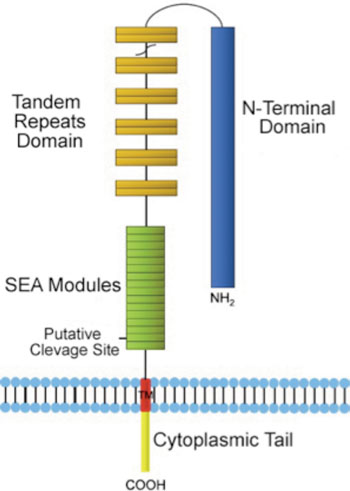New Microarray-Based Glycoprofiling Test Diagnoses Ovarian Cancer
By LabMedica International staff writers
Posted on 27 Mar 2014
Cancer researchers have developed a microarray assay that identifies the abnormally glycosylated surface residues associated with ovarian tumor biomarker proteins such as CA125.Posted on 27 Mar 2014
The CA125 biomarker assay plays an important role in the diagnosis and management of invasive ovarian cancer. However, a fundamental problem with CA125 is that it is not cancer-specific and may be elevated in benign gynecological conditions such as benign ovarian neoplasms and endometriosis.

Image: The structure of the CEA125 protein. CEA125 has three domains: the N-terminal domain, tandem repeats domain and C-terminal domain. The N-terminal domain and tandem repeats are heavily glycosylated (Photo courtesy of Wikimedia Commons).
Investigators at the University of Copenhagen (Denmark) based the development of a new assay system for glycoprofiling ovarian cancer on the observation that aberrant O-glycosylation was an inherent and specific property of cancer cells and could aid in differentiating cancer from these benign conditions, thereby improving specificity of the assay.
They developed a novel microarray-based platform for profiling specific aberrant glycoforms, such as Neu5Acalpha2,6GalNAc (STn) and GalNAc (Tn), present on CA125 and CA15-3. They used the assay to measure STn-CA125, ST-CA125, and STn-CA15-3 in a blinded study of a cohort of patients from the United Kingdom Ovarian Cancer Population Study who presented with elevated CA125 levels and a pelvic mass.
Results revealed that the combined glycoform profile was able to distinguish benign ovarian neoplasms from invasive epithelial ovarian cancer with a specificity of 61.1% at 90% sensitivity.
“All proteins have a type of sugar-coat – small, complicated sugar molecules that reside on a protein’s surface. When cancer is present in the body, we can observe a chemical change in this sugar-coat. It is a very complex phenomenon. Luckily, it is very simple to investigate and determine the presence of this transformed sugar coating,” said senior author Dr. Ola Blixt, professor of chemistry at the University of Copenhagen. “We have decided to publish these results, as opposed to taking out a patent. OK, we will not get rich, even though the market related to ovarian cancer is worth 170 million USD annually. On the other hand, any manufacturer is able to include this in their existing kit. And I hope that it happens soon.”
The study describing the ovarian cancer glycoprofiling assay was published in the January 29, 2014, online edition of the Journal of Proteome Research.
Related Links:
University of Copenhagen












.jpg)
